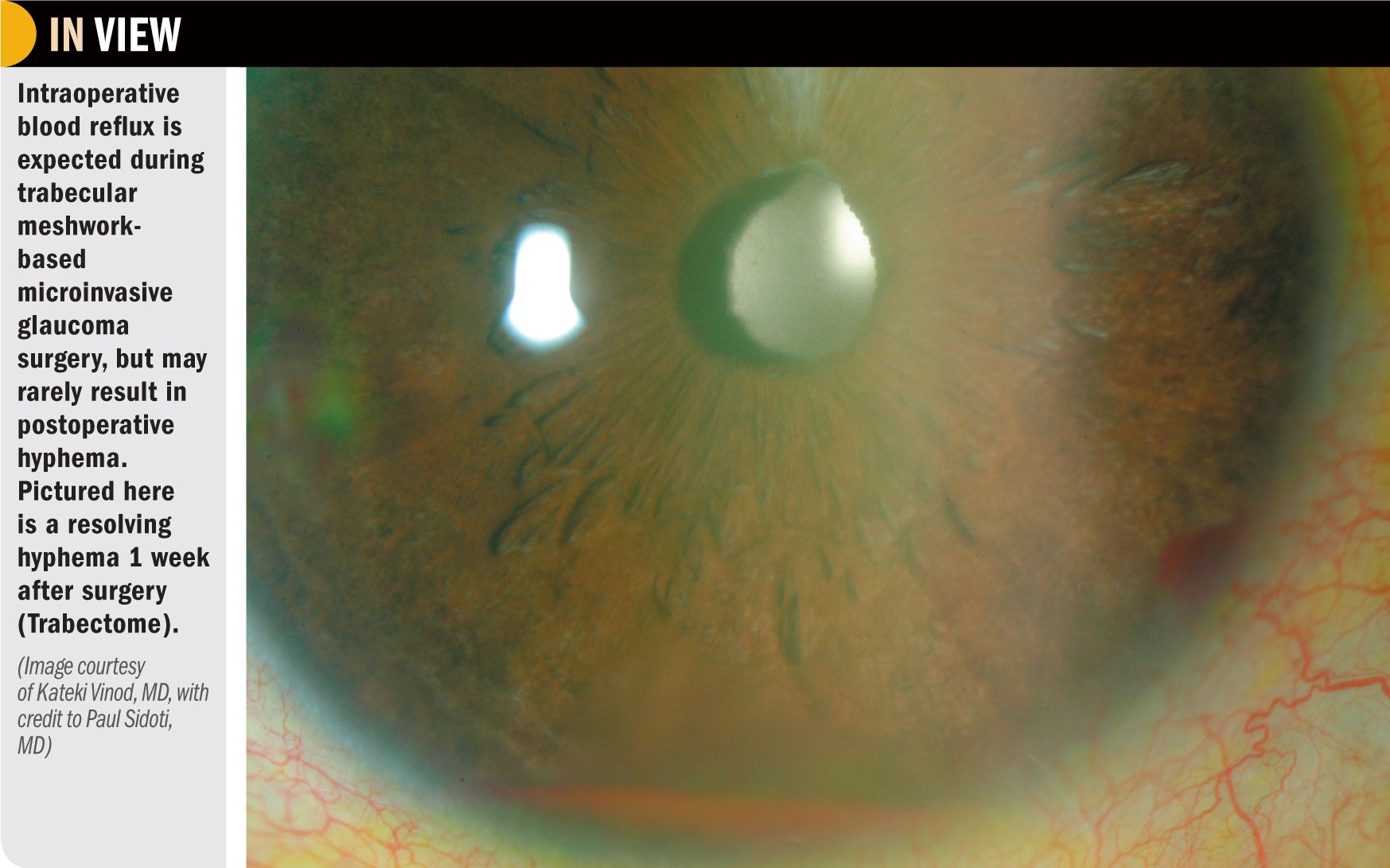Article
TM-based MIGS best practices
Author(s):
Surgical strategies can minimize risk by selecting appropriate patient, optimizing intraoperative view

The question of whether to perform phacoemulsification before or after TM-based MIGS is a matter of surgeon preference, says Kateki Vinod, MD.
Reviewed by Kateki Vinod, MD
Trabecular meshwork (TM)-based microinvasive glaucoma surgeries (MIGS) include both implanted stents as well as procedures for TM unroofing and ablation. Though generally among the safest glaucoma procedures, they are not without risk, said Kateki Vinod, MD. Complications associated with TM-based MIGS tend to be infrequent, self-limited, and non-vision threatening.
Nonetheless, surgeons can take steps preoperatively and during surgery to minimize risk, said Dr. Vinod, assistant professor, New York Eye and Ear Infirmary of Mount Sinai, New York.
Two main strategies for avoiding complications are selecting an appropriate patient and optimizing the intraoperative view, Dr. Vinod said. The ideal patient for TM-based MIGS has a clear cornea with no significant ocular surface disease, corneal opacities, or endothelial dysfunction.
A wide-open angle with well-delineated structures is also essential, as is the absence of prior angle-based surgery. Patients under consideration for TM-based MIGS should not have systemic morbidities that may compromise surgical success-for example, the inability to rotate the head and neck during surgery. One common concern related to patient selection is whether it is safe to perform TM-based MIGS in patients who are receiving anticoagulation or anti-platelet therapy for cardiac disease or stroke prevention.
“There is no evidence in the literature to support the interruption of blood thinners in any glaucoma surgery, including TM-based MIGS,” Dr. Vinod said. Though some surgeons may opt to hold anti coagulants-especially for 360° angle-based procedures-the decision should always be made in concert with the patient’s prescribing physician.
The second key to minimizing complications with TM-based MIGS is to optimize the intraoperative view of the angle. Performing gonioscopy during surgery is very different from doing so in the office, and there is a learning curve involved. Novice surgeons may find it useful to practice intraoperative gonioscopy at the end of routine cataract cases to increase their confidence. In general, the microscope is tilted 30° toward the surgeon and the patient’s head is tilted 30° away from the surgeon.
The surgeon should be able to comfortably hold the gonioprism in his or her non-dominant hand without exerting excessive pressure on the eye, which can cause corneal striae. Adequate anesthesia is critical and usually consists of some combination of topical and intracameral agents, Dr. Vinod said.
Beginning surgeons may consider a peribulbar or retrobulbar block to ensure patient comfort and minimize patient movement. Based on her experience, Dr. Vinod also recommends that the corneal wound should be constructed anterior to the limbal blood vessels to minimize the chance of bleeding onto the corneal surface, which can obscure the view intraoperatively.
Right time for phaco
The question of whether to perform phacoemulsification before or after TM-based MIGS is a matter of surgeon preference. Dr. Vinod said she leans toward performing MIGS first, especially when implanting a stent.
“Your view through the cornea is never going to be as clear as it is at the very beginning of the case,” she explained.
Clear visualization of the angle structure and identification of the TM is critical to maximize surgical success and avoid such complications as corneal damage, cyclodialysis cleft formation, and excessive bleeding. Some degree of reflux bleeding into the anterior chamber, however, is expected and indicates successful penetration of Schlemm’s canal.
Another pearl she offered could be helpful in patients with a lightly pigmented TM. In these cases, trypan blue dye may be used to stain the TM. Gentle decompression of the eye, which allows blood reflux into Schlemm’s canal, is an alternative to better delineate the TM.
Role of viscoelastic
Viscoelastic has several roles in TM-based MIGS-it is used as a coupling agent on the corneal surface as well as to widen the angle, except with a surgical system (Trabectome, NeoMedix Corp.), which has its own infusion. Viscoelastic can also help to tamponade active bleeding. Overfill may collapse Schlemm’s canal, leading to superficial stent implantation, and underfill may induce corneal striae.
Dr. Vinod noted that her preference is to use whichever viscoelastic already has been opened for the cataract portion of the case. In stand-alone MIGS procedures, she uses sodium hyaluronate 10 mg/mL, which is easiest to remove and less likely to cause an IOP spike postoperatively, she noted.
Final steps that reduce the risk of complications are ensuring a watertight wound closure, ideally with a 10-0 nylon suture, and pressurizing the eye before leaving the operating room. Dr. Vinod added that these strategies minimize the risk of postoperative bleeding, though hyphema may still rarely occur and typically resolve quickly.
Disclosures:

Kateki Vinod, MD
E: kvinod@nyee.edu
This article was adapted from Dr. Vinod’s presentation at the 2019 meeting of the American Glaucoma Society. Dr. Vinod did not report any financial disclosures
Newsletter
Don’t miss out—get Ophthalmology Times updates on the latest clinical advancements and expert interviews, straight to your inbox.




